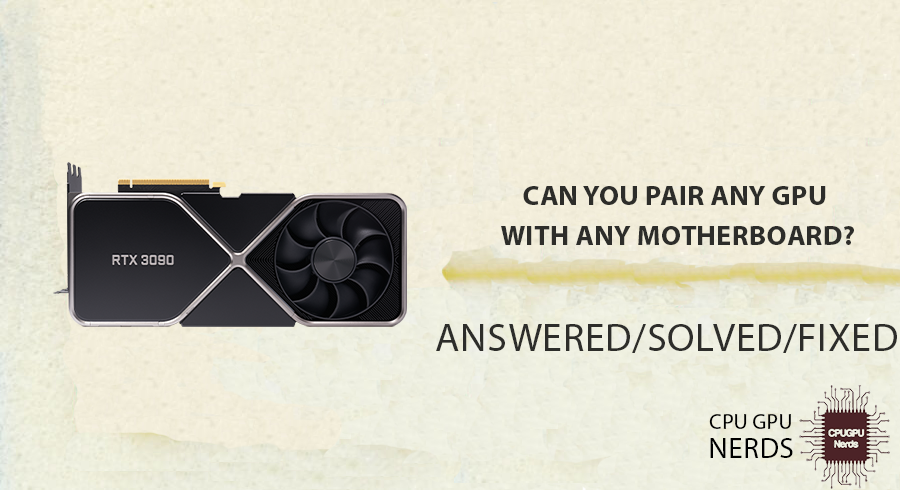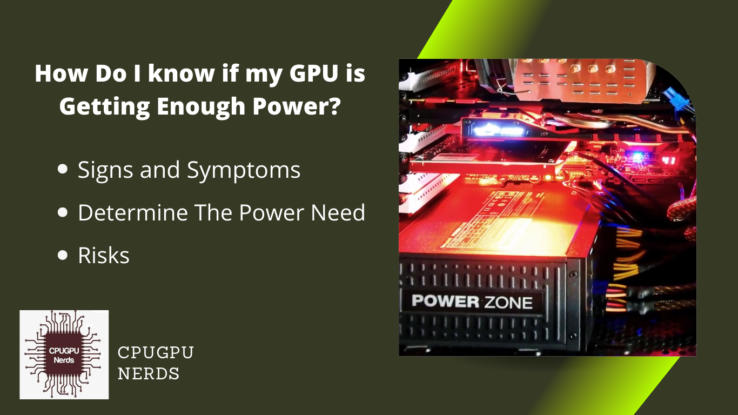The performance of a GPU highly depends on what type of motherboard and other hardware components you are using.
Picking the right components for a computer system can be daunting for many users. Selecting the GPU (Graphics Processing Unit) and motherboard can become especially tricky, as these two components must be compatible to ensure a successful pairing.
This article seeks to help you decide when choosing these components. We will explore the compatibility of GPUs and motherboards and the various factors affecting their compatibility.
Can You Pair Any GPU With Any Motherboard? Can It Be Incompatible?
When it comes to ensuring proper compatibility between a GPU and a motherboard, it is imperative to consider a few factors. From physical dimensions to interface standards, each component plays an important role in successfully pairing a GPU and a motherboard.
For example, a GPU may be physically too large to fit into some motherboards due to its form factor. At the same time, it may also be incompatible due to differences in slot dimensions.
PCI or PCIe ports
Additionally, power requirements must also be considered; GPUs require specific power inputs, as do motherboards, and if these do not match, there may be insufficient power for either component to operate.
The interface standard must match; GPUs and motherboards may use different interface standards, such as the PCI-Express x16 slot, and incompatibilities can arise from differences in these standards.
Size and Power of GPU
From the physical size of the GPU to its power requirements, selecting the right components is essential. The size of your GPU is an important factor to consider, as not all GPUs are designed to fit into every motherboard.
Choosing a GPU that is compatible with the slot on the motherboard is mandatory. What’s more, the physical size of the GPU may be too big for smaller cases. Therefore, it’s important to double-check the compatibility and measurements before making a purchase.
Power requirements are also something to consider. Different models and brands of GPUs have varying power requirements. It is necessary to ensure that your computer’s power supply unit (PSU) has sufficient wattage to handle the GPU you select. Usually, a minimum of 500 watts is enough for most GPUs, but some advanced options may require more.
Interface Protocol
Comprehension of the interface and protocols of the computer components is critical when trying to ensure that both your motherboard and graphics processing unit (GPU) interact with each other in the most efficient way possible.
Take, for instance, the case of PCIe 4.0; while newer GPUs may be equipped with the interface, not all motherboards may be capable of catering to this requirement. Likewise, certain display outputs, such as HDMI or DisplayPort, may not be compatible with the outputs of certain GPUs, as the motherboard itself may be limited to particular output options.
Can I Use an Old Graphics Card On a New Motherboard?
There is only one case; if your GPU has a PCI or PCIe slot that your card supports, you can use your old GPU with the new motherboard. But if you have a GPU with only a PCI slot and your motherboard only supports the PCIe slots. Then you can’t use your GPU on it.
It is essential to check that the slot on the new motherboard is compatible with the graphics card you wish to use. With PCI, AGP, and PCIe all having distinct specifications and designs, you will want to confirm that the graphics card and motherboard details match up.
Failure to do so could result in an inability to use your desired graphics card. Make sure to look at the specifications of the new motherboard and graphics card to guarantee they are compatible.
Before buying a graphics card for your system, it is important to consider the power requirements. Depending on the type of motherboard, you may need to upgrade to a newer power supply unit compatible with your graphics card.
It is essential to ensure that the PSU is equipped with enough and the right type of power connectors to provide your graphics card with the power it needs to run.
How To Select a Graphics Card For Your Motherboard?
Choosing a compatible graphics card is crucial if you’re looking for an enjoyable multimedia experience with your computer. You have to select your graphics card according to your motherboard. A few key factors must be considered to ensure you make the right pick.
Your Budget
There is a wide range of prices for graphics cards, and you should choose a card that is appropriate for the amount of money you have available. You should also consider how much it will cost to upgrade your motherboard if required for your prospective graphics card to function properly.
Compatibility With Motherboard and Other Components
When selecting a graphics card, compatibility should be the utmost concern. To that end, it is important to consider the type of interface the card requires and ensure it is compatible with your motherboard.
This interface is usually PCIe 3.0 or 4.0 in most modern boards. Additionally, pay attention to your card’s power and cooling requirements and ensure they are supported by the design of your motherboard.
Size of Card According To PC Case
Ensuring that the card size matches the slots on your motherboard is important. Usually, graphics cards occupy either one or two PCIe slots, so they can be used as an indicator of the size of the card.
If you use a big and heavy card and your motherboard is small, you might experience damage. Because of the size and weight of the card, your motherboard will not be able to handle it. Moreover, your PC case will also be according to the size of your motherboard, which is small. So, always consider the case size.
Performance of Graphics Card
Last but not least, the performance of the GPU matters the most. If you want a new graphics card, always look for the GPU to provide maximum support with your motherboard. If your motherboard does not support the GPU you plan to buy, you have to first upgrade your motherboard.
Do I Need the Same Brand of GPU and Motherboard?
Three major brands make GPUs: AMD, Asus, and NVIDIA. Only AMD and Asus make the motherboards. There is no performance difference if you buy the same or a different company motherboard and GPU. There could be a difference if you do not consider the compatibility while buying.
While this may be an option, several elements should be considered when pairing a GPU from one brand (e.g., NVIDIA or AMD) with a board from a different brand (e.g., ASUS or MSI).
For example, it is important to ensure that the graphics card and motherboard are compatible, that the graphics card has the necessary power supplies, and that the system’s overall performance meets the desired requirements.
As such, it is important to research any potential combination of components before purchase to ensure everything runs as expected. Without proper research, you might experience an underperforming GPU or motherboard.
Can A Faulty Graphic Card Damage Motherboard?
Although designed to work harmoniously, motherboard and graphic card hardware can sometimes clash. In some cases, problems can arise that result in system instability, but rarely does a faulty graphic card physically damage a motherboard directly. It can lead to overheating and then damage the motherboard.
Although it is not 100% guaranteed, the motherboard generally provides the necessary power and interface to the card, creating the chances of physical damage. Issues with either component can still arise, but a faulty graphic card, in most cases, will not directly harm the motherboard.
A faulty card could cause overheating, which is the root cause of many issues. Excessive heat can be detrimental to parts, such as the motherboard if not properly addressed.
It is because when a graphic card overheats due to poor cooling or a malfunctioning fan, the parts will expand and contract, potentially leading to physical damage.
To prevent such issues from arising, it’s important to actively monitor the temperature of your hardware and address any excessive heating immediately.
Conclusion
Navigating selecting a GPU and motherboard for your computing system can be complex. A range of incompatible components can lead to system damage or reduced performance, making it essential for users to be mindful of physical dimensions, interface standards, power requirements, and heat-dissipation needs when choosing.
Even though PCI, AGP, and PCIe each have unique characteristics, it is important to understand the motherboard and graphics card specs to guarantee seamless compatibility.
Meanwhile, you must consider your GPU’s budget, size, and compatibility. Equally important is ensuring that the power supply unit is compatible with your graphics card’s power needs and contains the appropriate power connectors.

Hey, I’m Hammad. I write for this website to help you with the IT advice about PC, RAM, CPU, Motherboard, PSU, and other PC components.
I will provide detailed guides with images, and explain step by step so you can understand the process. Check all my articles here.








